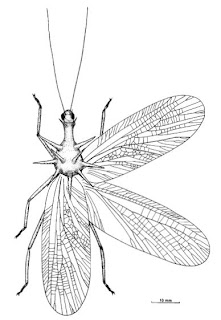Belongs within: Tettigonioidea.
The Conocephalinae is a diverse group of orthopterans including the snout-snosed and meadow katydids. Nymphs of the Conocephalini, the meadow katydids, are often predaceous and may act as predators of crop pests, though their value is somewhat counter-acted by the feeding of the more herbivorous adults (Rentz 1996). The Copiphorini, cone-headed katydids, have a cone-shaped projection on the head protruding forward of the base of the antennae.
Characters (from Rentz 1996): Fastigium of vertex variable. Antennal sockets not strongly rimmed. Thoracic auditory opening large, elongate. Fore tibia usually with spines not unusually lengthened and not as long as combined lengths of first two tarsal segments. Male with stridulatory organ at base of tegmen.
<==Conocephalinae [Conocephalidae]
| i. s.: Xiphidion K14
| |--X. affine K14
| |--X. fuscum B01
| `--X. modestum K14
| Odontoxiphidium BM76
| Orchelimum BM76
| |--O. concinnum RH15
| `--O. fidicinium L67
| Caulopsis gracilis R15
|--Coniungopterini R96
| |--Metholce nigritarsis R96
| |--Coniungoptera R96
| `--Veria colorata R96
|--Conocephalus [Conocephalini] R96
| |--C. albescens R96
| |--C. maculatus BM76
| |--C. redtenbacheri R96
| |--C. saltator RH15
| |--C. semivittatus R96
| | |--C. s. semivittatus R96
| | `--C. s. vittatus R96
| `--C. upoluensis R96
|--Agraeciini [Agroeciinae] R96
| |--Dicranocercus R96
| |--Coptaspis crassinervosa R96, K14
| |--Paralobaspis R18
| | |--*P. picta R18
| | `--P. personata Rehn 1918 R18
| |--Salomona R96
| | |--S. francoisi K14
| | |--S. rouxi Karny 1914 K14
| | `--S. solida [incl. S. godeffroyi] K14
| |--Austrosalomona R96
| | |--A. falcata R96
| | |--A. personafrons R96
| | `--A. zentae R96
| `--Nicsara R96
| |--N. bifasciata R96
| |--N. cornuta R96
| `--N. spuria R96
`--Copiphorini [Copiphorinae] R96
|--Copiphora cornuta (DeGeer 1773) [=Locusta cornuta] R18
|--Acantheremus elegans Karny 1907 R18
|--Mygalopsis R96
| |--M. pauperculus R96
| `--M. sandowi R96
|--Neoconocephalus R18
| |--N. fratellus (Griffini 1899) [=Conocephalus fratellus, C. frater Redtenbacher 1891 non Kirby 1890] R18
| |--N. fuscomarginatus R15
| |--N. nigropunctatus (Redtenbacher 1891) [=Conocephalus nigropunctatus] R18
| |--N. procerus R15
| |--N. redtenbacheri R15
| |--N. saturatus R15
| `--N. vicinus R15
|--Homorocoryphus R18
| |--H. brunneri (Redtenbacher 1891) [=Conocephalus brunneri] R18
| |--H. cocanus (Bolivar 1881) [=Conocephalus cocanus] R18
| |--H. kraussi R15
| `--H. viridis R15
|--Pseudorhynchus R96
| |--P. lessonii R96
| |--P. mimeticus R96
| `--P. selonis R96
`--Euconocephalus R96
|--E. broughtoni R96
|--E. extensor [incl. E. australis] K14
`--E. lineatipes K14
*Type species of generic name indicated
REFERENCES
[BM76] Bohart, R. M., & A. S. Menke. 1976. Sphecid Wasps of the World. University of California Press: Berkeley.
[B01] Bolivar, I. 1901. Orthopterák [Orthoptères]. In: Horváth, G. (ed.) Zichy Jenő Gróf Harmadik Ázsiai Utazása [Dritte Asiatische Forschungsreise des Grafen Eugen Zichy] vol. 2. Zichy Jenő Gróf Harmadik Ázsiai Utazásának Állattani Eredményei [Zoologische Ergebnisse der Dritten Asiatischen Forschungsreise des Grafen Eugen Zichy] pp. 223–243. Victor Hornyánszky: Budapest, and Karl W. Hierseman: Leipzig.
[K14] Karny, H. 1914. Conocephalidae Neu-Caledoniens und der Loyalty-Inseln. In: Sarasin, F., & J. Roux (eds) Nova Caledonia: Forschungen in Neu-Caledonian und auf den Loyalty-Inseln. A. Zoologie vol. 1 pt 4 pp. 447–449. C. W. Kreidels Verlag: Wiesbaden.
[L67] Lin, C. S. 1967. Nesting behavior of Tachytes (Tachyplena) praedator Fox, with a review of the biology of the genus (Hymenoptera: Sphecidae: Larrinae). American Midland Naturalist 77 (1): 241–245.
[R15] Rehn, J. A. G. 1915. A further contribution to the knowledge of the Orthoptera of Argentina. Proceedings of the Academy of Natural Sciences of Philadelphia 67 (2): 270–292.
[R18] Rehn, J. A. G. 1918. On a collection of Orthoptera from the State of Pará, Brazil. Proceedings of the Academy of Natural Sciences of Philadelphia 70: 144–236, pls 1–2.
[RH15] Rehn, J. A. G., & M. Hebard. 1915. The genus Gryllus (Orthoptera) as found in America. Proceedings of the Academy of Natural Sciences of Philadelphia 67 (2): 293–322.
[R96] Rentz, D. 1996. Grasshopper Country: The abundant orthopteroid insects of Australia. University of New South Wales Press: Sydney.
Last updated: 23 October 2017.









